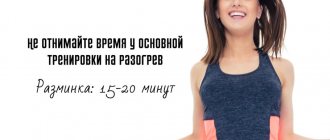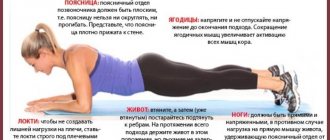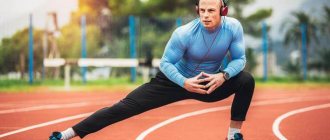Why do you need to stretch?
There are many benefits to regularly stretching:
- Reduces muscle stiffness and increases range of motion.
Stretching slows down joint degeneration, resulting in increased flexibility and the ability to perform daily activities with relative ease. In addition, it cannot be denied that the more flexible you are, the wider the amplitude of movements, and accordingly, the training becomes more intense. - Increases blood flow to muscles
. Doing stretching on a regular basis can improve your circulation. In turn, good blood supply increases the supply of nutrients to the muscles, helps reduce their recovery time and reduce soreness that occurs after training. - Improves posture and reduces back pain.
According to one study, combining strength training with stretching exercises can reduce musculoskeletal pain and keep the spine in proper alignment. - Relieves stress.
Combining stretching exercises with deep breathing relieves tension in the muscles and relaxes them. You may not notice it, but emotional stress causes your muscles to tense and tighten. Typical areas that may suffer from stress-related pain are the neck, upper back and shoulders. Pay enough attention to these areas.
There is no consensus among scientists regarding the reduction in the risk of injury due to stretching. This is also evidenced by a study conducted in 2001 by a scientist named Ian Shrier. It states that injuries do not occur due to lack of muscle flexibility, but due to improper exercise technique, excessive stress and an inappropriate range of motion. Stretching can reduce muscle tension, but is not a panacea for injuries.
What else is stretching useful for?
On weekdays, we often freeze in the same positions for a long time - we sit in front of the computer, crook our posture and don’t think about the consequences. In the evenings, as a rule, we return home with pain in the head, neck and back.
Stretching will help avoid unpleasant sensations. After just a couple of workouts, your muscles will relax and then become stronger, and the feeling of tightness will occur much less often.
Stretching leads to optimal blood supply to all organs in the body, and this helps us get rid of accumulated stress. During classes, I notice that there seem to be no thoughts at all. The diary in your head, frantically planning meetings, calls and trips, turns off and turns into a gramophone playing a pleasant melody. At this hour, I don’t think about my phone at all and have the opportunity to completely legally not check my mail and inboxes.
After several workouts, the result is noticeable - muscle tightening in the areas where cellulite most often forms (on the stomach and in the inner thighs), which means I’m no longer afraid of it. In addition, the body has become noticeably more prominent. The progress in the splits is obvious and I can confidently say, “Paul, I’m close.”
View this post on Instagram
Static and dynamic stretching
In fact, there are many more types of stretching, including:
- Static
- Passive
- Dynamic
- Ballistic
- Active isolated
- Isometric
- Proprioceptive neuromuscular
Most of them are used by professional athletes and require implementation under the strict guidance and supervision of specialists to avoid injury.
Stretching for beginners or amateurs is usually limited to static and dynamic.
What are their differences?
Dynamic stretching
usually performed before training. It raises body temperature and allows muscles to contract more efficiently and generate more force, prepares the heart and lungs for vigorous activity, delivers oxygen more efficiently to working muscles and lengthens them, thereby improving joint range of motion.
That is, these are springy and amplitude movements such as swings, rolls, rotations, kicks and punches, etc.
According to the study, dynamic muscle stretching is especially recommended for those who enjoy running, team sports like football and basketball, and strength training in the gym or at home.
Static stretching
involves fixing the body in one position for 15-30 seconds. Performed in response to specific muscle tension or soreness. Exercises related to this type of stretching: bending forward, backward and towards the floor, fold, “butterfly” and others.
Static stretching is recommended to be done after training or as an independent activity.
General recommendations for stretching
Here are some tips to keep in mind when stretching to get the most benefit:
- Stretching ≠ warming up. Many people confuse these concepts or believe that they are interchangeable, but this is not the case. Before stretching, you need to pre-warm up your muscles; walking at an easy pace for 5 minutes is great for this. Then you can proceed directly to stretching. Some people deliberately avoid warming up and immediately begin the so-called “cold stretching”, but there is no clear opinion regarding its effectiveness.
- When statically stretching muscles, hold the position for at least 10-30 seconds to ensure the load is safe and effective.
- It is not normal to feel pain when stretching. Reduce the amplitude and make the process smoother.
- Remember to breathe properly while stretching. Many people make the mistake of holding their breath, freezing in position.
- Most experts recommend stretching from top to bottom, that is, from head to toe. The movements should not be chaotic, perform them sequentially: head, neck, shoulders, arms, back, chest, lower back, hips, legs, etc.
- You can stretch before and after major physical activity. Give her at least 15 minutes. If stretching is an end in itself and is the only activity where all muscle groups are worked out, then it will take at least half an hour.
Stretching exercises
The main advantage of all the exercises is that they are great for both the street, the fitness club, and for stretching at home.
Head tilts
First, tilt your head to the side, trying to touch your ear to your shoulder, repeat the movement in the other direction. Then tilt your head forward and back, return to the starting position and look left and right, turning your head all the way. It is important that your back remains straight. Avoid sudden and springy movements. The exercise can be performed both sitting and standing, and you can also help yourself with your hands during the process.
Exercises for stretching the shoulder girdle and arms
An exercise familiar to everyone from school is ideal for stretching the posterior delta and rotator cuff. Straighten your arm, press it slightly above your chest (parallel to the floor), rest the palm of your other hand on the elbow joint and, as a lever, try to direct it as much as possible in the opposite direction. Hold the position for at least 10 seconds, then change hands. It is important not to turn the body while doing this.
Folding your hands behind your back will help you stretch your triceps and shoulders. To do this, place one hand across your back from below, palm up, and the other through the top, palm down. In this case, the hands are pressed as close as possible to the back, and the elbows are directed up and down. Your task is to clasp your fingers or touch them and fix this position for at least 10 seconds, and then change sides.
Stretching the anterior muscles of the shoulder girdle is performed as follows: place your right hand behind your back, grab its wrist with your left hand and move it as far back as possible. Do this smoothly and without sudden movements. At the peak point, stop and hold the position for at least 10 seconds, then change hands and do the same.
Do not neglect the usual swings of your arms back and forth. Do 20 rotations with straight arms forward and then in the opposite direction. To develop coordination, you can diversify the exercise by making a circular movement of one hand forward and the other back.
Don't forget to rotate your forearms. Stretch your arms to the sides and rotate your elbow joint with your forearms in the middle and outwards for 15-20 repetitions.
Finish the process by rotating the brushes. Clasp your hands and perform rotations in both directions for 30 seconds.
Exercises to stretch the chest muscles
Place one hand on the wall, lower your shoulder and slowly turn in the opposite direction. Then repeat the action with the other hand.
Another effective method is stretching the pectoral muscles with both hands behind your back. Place your palms together and raise your arms, without bending your elbows, as high as possible. You can also make the exercise more difficult by bending forward with a straight back.
The following exercise is especially useful for people with poor posture. To perform it, rest your palms on the wall, then begin to move away from the wall, bending your body as low as possible so that it becomes parallel to the floor. Make sure that your palms do not slide down and remain higher than your body. The head should form a straight line with the body, gaze directed at the floor.
Exercises to stretch the back muscles
Stand straight, place your feet shoulder-width apart. Start doing slow side bends. Make sure your body doesn't bend forward or backward as you do this. Do 10 reps on each side.
Then do another type of bending. Place your feet slightly wider than shoulder-width apart, extend your arms out to the sides so they are parallel to the floor, then slowly lower down until you touch your shin. Grab it with your hand and hold this position for 10 seconds. The gaze should be directed upward. Switch sides.
Also use classic forward bends with your palms touching the floor.
To warm up your trapezius muscles, stand with your feet together and bend your knees slightly. Hands in front of you, palms placed on top of head. In this position, helping with your hands, try to round your back as much as possible in the area of the shoulder blades, trying to bring your chin closer to your chest.
Child's pose is suitable for stretching the latissimus dorsi muscles and intervertebral discs; it is often used in yoga. Take a position on the floor with your feet and knees together, lower your pelvis onto your heels, and then, as you exhale, slowly lower yourself down with your arms straight until your forehead touches the floor. Hold this position for 10-20 seconds and return to the starting position.
From this exercise you can go into another one called “downward-facing dog.” It stretches the back of the legs and back muscles well, lengthens the spine and removes tension in the cervical region. Get down on your knees, sit on your heels and stretch your arms forward, palms should be pressed to the floor. Make sure your arms and legs are shoulder-width apart. From this position, smoothly rise up, observing the important condition - your back should remain straight. If you don't have enough stretch, lift your heels off the floor or bend your knees.
To work the gluteus maximus, as well as the external obliques and rectus muscles, lie on your back, lift your bent right leg and move it to the left so that your knee touches the floor. You can help yourself with your hand. At the same time, make sure that your head, shoulder blades and back do not come off the mat. Freeze in this position for 15 seconds and then change legs.
Abdominal stretching exercises
Another exercise actively used in yoga is called “camel pose.” Kneel down with your feet hip-width apart, slowly lean back, and rest your hands on your heels. The chest should be directed upward, the head thrown back, and the shoulder blades brought together. Stay in this position for 15 seconds.
Another simple way to stretch the rectus abdominis, iliacus and externus muscles is to bend backwards. Hands can be kept lowered or raised, the gaze should be directed upward. A similar effect can also be obtained from the upward-facing dog exercise, which is performed while lying on the mat.
Leg muscle stretching exercises
- Stretching with legs apart. We sit on the floor. The legs are spread to the side like a cross split. The piriformis muscle is well worked out. We tilt the body slightly forward.
- Here’s another exercise for the piriformis muscle—lying stretch. We lie on our backs, legs bent at the knees. We place the ankle of one leg on top of the other just above the knee. We lift the lower leg off the floor and pull it towards the chest. Then repeat on the other side.
- And finally the last exercise for the piriformis muscle. We lie on our backs, one leg lies straight, the other is bent at the knee and stretches to the floor to the side, while the back does not come off the floor.
- Achilles tendon stretch. Go to the wall. Stand on the platform with your toes and your heels towards the floor. Get up on your toes and go down.
- The frog is a good exercise for stretching the hip joint.










